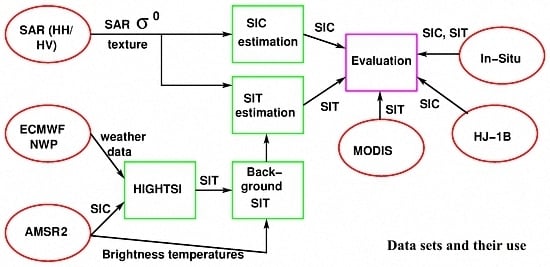Bohai Sea Ice Parameter Estimation Based on Thermodynamic Ice Model and Earth Observation Data
Abstract
:1. Introduction
1.1. Overview of Previous Studies on Sea Ice Concentration and Thickness Retrieval
1.1.1. Sea Ice Concentration
1.1.2. Sea Ice Thickness
2. Study Area
3. Data Sets and Their Processing
3.1. RADARSAT-2 SAR
3.1.1. SAR Data Pre-Processing
3.1.2. SAR Features
3.2. AMSR2 Radiometer
3.3. HJ-1B Optical Imagery
3.4. MODIS Spectrometer Imagery
3.4.1. MODIS Ice Thickness Charts
3.4.2. MODIS Optical Imagery Open-Water-Sea Ice Chart
3.5. In-Situ Data
3.6. Thermodynamic Sea Ice Model HIGHTSI
4. Estimation of Sea Ice Concentration and Thickness
4.1. Background Ice Thickness Fields Based on HIGHTSI and AMSR2 Radiometer Data
4.2. Sea Ice Concentration Estimation and Ice/Open-Water Discrimination Based on SAR Imagery
4.2.1. Linear Model Between in-Situ SIC and SAR Data
4.2.2. SIC Estimation with a Neural Network Approach
4.2.3. Evaluation of the SIC Estimates
4.3. Ice Thickness Estimation Based on the Background Field and SAR
Evaluation of the SIT Estimates Using MODIS SIT
5. Bohai Sea Ice Volume
6. Discussion
7. Conclusions
Acknowledgments
Author Contributions
Conflicts of Interest
References
- Bai, S.; Liu, Q.; Hai, H.L. Sea ice in the Bohai Sea of China. Mar. Forecast 1999, 16, 1–9. (In Chinese) [Google Scholar]
- Li, Z.; Wang, Y. Statistical ice conditions of Bohai Sea. In Proceedings of the International Conference on Offshore Mechanics and Arctic Engineering, Rio de Janeiro, Brazil, 3–8 June 2001; Volume 4, pp. 1–6.
- Yang, G. Bohai Sea Ice Conditions. J. Cold Reg. Eng. 2000, 14, 54–67. [Google Scholar] [CrossRef]
- Wu, H. Mathematic representations of sea ice dynamic thermodynamic processes. Oceanol. Limnol. Sin. 1991, 22, 321–328. (In Chinese) [Google Scholar]
- Shan, S.; Wu, H. Numerical sea ice forecast for the Bohai Sea. Acta Meteorol. Sin. 1998, 2, 139–153. (In Chinese) [Google Scholar]
- Comiso, J.C. SSM/I Sea Ice Concentrations Using the Bootstrap Algorithm; NASA Reference Publication 1380; Goddard Space Flight Center: Greenbelt, MD, USA, 1995.
- Spreen, G.; Kaleschke, L.; Heygster, G. Sea ice remote sensing using AMSR-E 89-GHz channels. J. Geophys. Res. 2008, 113, C02S03. [Google Scholar] [CrossRef]
- Drüe, C.; Heinemann, G. High-resolution maps of the sea-ice concentration from MODIS satellite data. Geophys. Res. Lett. 2004, 31, L20403. [Google Scholar] [CrossRef]
- Bovith, T.; Andersen, S. Sea Ice Concentration from Single-Polarized SAR data using Second-Order Grey Level Statistics and Learning Vector Quantization; Scientific Report 05-04; Danish Meteorological Institute: Copenhagen, Denmark, 2005. [Google Scholar]
- Berg, A. Spaceborne SAR in Sea Ice Monitoring: Algorithm Development and Validation for the Baltic Sea; Technical Report 47L; Chalmers University of Technology: Gothenburg, Sweden, 2011. [Google Scholar]
- Berg, A.; Eriksson, L.E.B. SAR Algorithm for Sea Ice Concentration—Evaluation for the Baltic Sea. IEEE Geosci. Remote Sens. Lett. 2012, 9, 938–942. [Google Scholar] [CrossRef]
- Berg, A. Spaceborne Synthetic Aperture Radar for Sea Ice Observations, Concentration and Dynamics. Ph.D. Thesis, Chalmers University of Technology, Gothenburg, Sweden, 2014. [Google Scholar]
- Karvonen, J. Baltic Sea Ice Concentration Estimation Based on C-Band HH-Polarized SAR Data. IEEE J. Sel. Top. Appl. Earth Obs. Remote Sens. 2012, 5, 1874–1884. [Google Scholar] [CrossRef]
- Karvonen, J.; Cheng, B.; Vihma, T.; Arkett, M.; Carrieres, T. A method for sea ice thickness and concentration analysis based on SAR data and a thermodynamic model. Cryosphere 2012, 6, 1507–1526. [Google Scholar] [CrossRef]
- Karvonen, J. Baltic Sea ice concentration estimation based on C-Band HH-Polarized SAR data. IEEE J. Sel. Top. Appl. 2012, 5, 1874–1884. [Google Scholar] [CrossRef]
- Karvonen, J. Baltic Sea ice concentration estimation based on C-Band Dual-Polarized SAR data. IEEE Trans. Geosci. Remote Sens. 2014, 52, 5558–5566. [Google Scholar] [CrossRef]
- Karvonen, J. Evaluation of the operational SAR based Baltic Sea ice concentration products. Adv. Space Res. 2015, 56, 119–132. [Google Scholar] [CrossRef]
- Clausi, D.A.; Jernigan, M.E. Designing Gabor filters for optimal texture separability. Pattern Recognit. 2000, 33, 1835–1849. [Google Scholar] [CrossRef]
- Clausi, D.A. Comparison and fusion of co-occurrence, Gabor, and MRF texture features for classification of SAR sea ice imagery. Atmos. Oceans 2001, 39, 183–194. [Google Scholar] [CrossRef]
- Deng, H.; Clausi, D.A. Gaussian MRF rotation- invariant features for image classification. IEEE Trans. Pattern Anal. Mach. Intell. 2004, 26, 951–955. [Google Scholar] [CrossRef] [PubMed]
- Deng, H.; Clausi, D.A. Unsupervised segmentation of synthetic aperture radar sea ice imagery using a novel Markov random field model. IEEE Trans. Geosci. Remote Sens. 2005, 43, 528–538. [Google Scholar] [CrossRef]
- Maillard, P.; Clausi, D.A.; Deng, H. Map-guided sea ice segmentation and classification using SAR imagery and a MRF segmentation scheme. IEEE Trans. Geosci. Remote Sens. 2005, 43, 2940–2951. [Google Scholar] [CrossRef]
- Yu, Q.; Clausi, D.A. SAR sea-ice image analysis based on iterative region growing using semantics. IEEE Trans. Geosci. Remote Sens. 2007, 45, 3919–3931. [Google Scholar] [CrossRef]
- Ochilov, S.; Clausi, D.A. Operational SAR Sea-Ice Classification. IEEE Trans. Geosci. Remote Sens. 2012, 50, 4397–4408. [Google Scholar] [CrossRef]
- Haralick, R.M.; Shanmugam, K.; Dinstein, I. Textural Features for Image Classification. IEEE Trans. Syst. Man Cybern. 1973, SMC-3, 610–621. [Google Scholar] [CrossRef]
- Rue, H.; Held, L. Gaussian Markov Random Fields: Theory and Applications; CRC Press: Boca Raton, FL, USA, 2005. [Google Scholar]
- Pichler, O.; Teuner, A.S.; Hosticka, B.J. A comparison of texture feature extraction using adaptive Gabor filtering, pyramidal and tree structured wavelet transforms. Pattern Recognit. 1996, 29, 733–742. [Google Scholar] [CrossRef]
- Scheuchl, B.; Flett, D.; Caves, R.; Cumming, I. Potential of RADARSAT-2 data for operational sea ice monitoring. Can. J. Remote Sens. 2004, 30, 448–461. [Google Scholar] [CrossRef]
- Horstmann, J.; Koch, W.; Lehner, S.; Tonboe, R. Wind Retrieval over the Ocean using Synthetic Aperture Radar with C-band HH Polarization. IEEE Trans. Geosci. Remote Sens. 2000, 38, 2122–2130. [Google Scholar] [CrossRef]
- Vachon, P.W.; Wolfe, J. C-Band Cross-Polarization Wind Speed Retrieval. IEEE Geosci. Remote Sens. Lett. 2011, 8, 456–459. [Google Scholar] [CrossRef]
- Karvonen, J.; Simila, M.; Makynen, M. Open Water Detection from Baltic Sea Ice Radarsat-1 SAR Imagery. IEEE Geosci. Remote Sens. Lett. 2005, 2, 275–279. [Google Scholar] [CrossRef]
- Geldsetzer, T.; Yackel, J.J. Sea ice type and open water discrimination using dual co-polarized C-band SAR. Can. J. Remote Sens. 2009, 35, 73–84. [Google Scholar] [CrossRef]
- Scott, K.A.; Xu, L.; Clausi, D.A. Sea ice concentration estimation during melt from dual-pol SAR scenes using deep convolutional neural networks: A case study. IEEE Trans. Geosci. Remote Sens. 2016, 54, 4524–4533. [Google Scholar]
- Laxon, S.; Peacock, N.; Smith, D. High interannual variability in sea ice thickness in the Arctic region. Nature 2003, 425, 947–950. [Google Scholar] [CrossRef] [PubMed]
- Kwok, R.; Rothrock, D.A. Decline in Arctic sea ice thickness from submarine and ICESat records: 1958–2008. Geophys. Res. Lett. 2009, 36, L15501. [Google Scholar] [CrossRef]
- Lee, S.; Im, J.; Kim, J.; Kim, M.; Shin, M.; Kim, H.-C.; Quackenbush, L.J. Arctic Sea Ice Thickness Estimation from CryoSat-2 Satellite Data Using Machine Learning-Based Lead Detection. Remote Sens. 2016, 8. [Google Scholar] [CrossRef]
- Mäkynen, M.; Similä, M. Thin ice detection in the Barents and Kara Seas with AMSR-E and SSMIS radiometer data. IEEE Trans. Geosci. Remote Sens. 2015, 53, 5036–5053. [Google Scholar] [CrossRef]
- Kaleschke, L.; Tian-Kunze, X.; Maass, N.; Mäkynen, M.; Drusch, M. Sea ice thickness retrieval from SMOS brightness temperatures during the Arctic freeze-up period. Geophys. Res. Lett. 2012, 39, L05501. [Google Scholar] [CrossRef]
- Yu, Y.; Rothrock, D.A. Thin ice thickness from satellite thermal imagery. J. Geophys. Res. 1996, 101, 25753–25766. [Google Scholar] [CrossRef]
- Makynen, M.; Cheng, B.; Simila, M. On the accuracy of thin-ice thickness retrieval using MODIS thermal imagery over Arctic first-year ice. Ann. Glaciol. 2013, 54, 87–96. [Google Scholar] [CrossRef]
- Zeng, T.; Shi, L.; Mäkynen, M.; Cheng, B.; Zou, J.; Zhang, Z. Sea ice thickness analyses for the Bohai Sea using MODIS thermal infrared imagery. Acta Oceanol. Sin. 2016, 35, 96–104. [Google Scholar] [CrossRef]
- Ning, L.; Xie, F.; Gu, W.; Xu, Y.; Huang, S.; Yuan, S.; Cui, W.; Levy, J. Using remote sensing to estimate sea ice thickness in Bohai Sea, China based on ice type. Int. J. Remote Sens. 2009, 30, 4539–4552. [Google Scholar] [CrossRef]
- Su, H.; Wang, Y. Using MODIS data to estimate sea ice thickness in the Bohai Sea (China) in the 2009–2010 winter. J. Geophys. Res. 2012, 117, C10018. [Google Scholar] [CrossRef]
- Yuan, S.; Gu, W.; Xu, Y.; Wang, P.; Huang, S.; Le, Z.; Cong, J. The estimate of sea ice resources quantity in the Bohai Sea based on NOAA/AVHRR data. Acta Oceanol. Sin. 2012, 31, 33–40. [Google Scholar] [CrossRef]
- Liu, C.; Wei, G.; Chao, J.; Yuan, S.; Xu, Y. Spatio-temporal characteristics of the sea-ice volume of the Bohai Sea, China, in winter 2009/10. Ann. Glaciol. 2013, 54, 97–104. [Google Scholar] [CrossRef]
- Xu, Z.; Yang, Y.; Wang, G.; Cao, W.; Li, Z.; Sun, Z. Optical properties of sea ice in Liaodong Bay, China. J. Geophys. Res. 2012, 117, C03007. [Google Scholar] [CrossRef]
- Similä, M.; Mäkynen, M.; Heiler, I. Comparison between C band synthetic aperture radar and 3-D laser scanner statistics for the Baltic Sea ice. J. Geophys. Res. Oceans 2010, 115, C10056. [Google Scholar] [CrossRef]
- Wakabayashi, H.; Matsuoka, T.; Nakamura, K.; Nishio, F. Polarimetric characteristics of sea ice in the Sea of Okhotsk observed by airborne L-band SAR. IEEE Trans. Geosci. Remote Sens. 2004, 42, 2412–2425. [Google Scholar] [CrossRef]
- Zhang, X.; Zhang, J.; Meng, J.; Su, T. Analysis of multi-dimensional SAR for determining the thickness of thin ice sea ice in the Bohai Sea. Chin. J. Oceanol. Limnol. 2013, 31, 681–698. [Google Scholar] [CrossRef]
- Zhang, X.; Dierking, W.; Zhang, J.; Meng, J. A polarimetric decomposition method for ice in the Bohai Sea using C-band PolSAR data. IEEE J. Sel. Top. Appl. Earth Obs. Remote Sens. 2015, 8, 47–66. [Google Scholar] [CrossRef]
- Karvonen, J.; Similä, M.; Heiler, I. Ice Thickness Estimation Using SAR Data and Ice Thickness History. In Proceedings of the IEEE International Geoscience and Remote Sensing Symposium 2003 (IGARSS’03), Toulouse, France, 21–25 July 2003; pp. 74–76.
- Karvonen, J.; Cheng, B.; Vihma, T. Estimation of Sea Ice Parameters Based on X-Band SAR Data and Thermodynamic Snow/Ice Modelling for the Caspian Sea. In Proceedings of the International Conferences on Port and Ocean Engineering under Arctic Conditions (POAC’13), Espoo, Finland, 9–13 June 2013; Available online: http://www.poac.com/Papers/2013/pdf/POAC13_029.pdf (accessed on 2 March 2013).
- Karvonen, J.; Cheng, B.; Similä, M. Baltic Sea Ice Thickness Charts Based on Thermodynamic Ice Model and SAR Data. In Proceedings of the International Geoscience and Remote Sensing Symposium 2007 (IGARSS’07), Barcelona, Spain, 23–27 July 2007; pp. 4253–4256.
- Karvonen, J.; Cheng, B.; Simila, M. Ice thickness charts produced by C-band SAR imagery and HIGHTSI thermodynamic ice model. In Proceedings of the Sixth Workshop on Baltic Sea Ice Climate, Lammi, Finland, 25–28 August 2008; pp. 71–81.
- Similä, M.; Mäkynen, M.; Cheng, B.; Rinne, E. Multisensor data and thermodynamic sea-ice model based sea-ice thickness chart with application to the Kara Sea, Arctic Russia. Ann. Glaciol. 2013, 54, 241–252. [Google Scholar] [CrossRef]
- Similä, M.; Mäkynen, M.; Karvonen, J.; Gegiuc, A.; Gierisch, A. Modeled sea ice thickness enhanced by remote sensing data. In Proceedings of the European Space Agency Living Planet Symposium, Prague, Czech Republic, 9–13 May 2016.
- RADARSAT-2 Product Description; RN-SP-52-1238, Issue 1/13; MacDonald, Dettwiler and Associates Ltd.: Richmond, BC, Canada, 2016.
- Besag, J. On the statistical analysis of dirty pictures. J. R. Stat. Soc. B 1986, 48, 259–302. [Google Scholar] [CrossRef]
- Shannon, C.E. A Mathematical Theory of Communication. Bell Syst. Tech. J. 1948, 27, 623–656. [Google Scholar] [CrossRef]
- Simila, M. SAR image segmentation by a two-scale contextual classifier. In Proceedings of the SPIE Conference Image and Signal Processing for Remote Sensing, Rome, Italy, 26 September 1994; Volume 2315, pp. 434–443.
- Ojala, T.; Pietikainen, M.; Harwood, D. A Comparative Study of Texture Measures with Classification Based on Feature Distributions. Pattern Recognit. 1996, 29, 51–59. [Google Scholar] [CrossRef]
- Karvonen, J. Virtual radar ice buoys—A method for measuring fine-scale sea ice drift. Cryosphere 2016, 10, 29–42. [Google Scholar] [CrossRef]
- Cressie, N. Statistics for Spatial Data; Wiley: New York, NY, USA, 1993; pp. 69–101. [Google Scholar]
- Japan Aerospace Exploration Agency (JAXA). Global Change Observation Mission Water (GCOM-W1) AMSR2 Level 1 Product Format Specification; Report No. SGC-120003; Japan Aerospace Exploration Agency (JAXA): Tokyo, Japan, 2012.
- Steffen, K.; Key, J.; Cavalieri, D.J.; Comiso, J.; Gloersen, P.; St. Germain, K.; Rubinstein, I. The estimation of geophysical parameters using passive microwave algorithms. In Microwave Remote Sensing of Sea Ice; Carsey, F.D., Ed.; American Geophysical Union: Washington, DC, USA, 1992; pp. 201–231. [Google Scholar]
- Su, H.; Wang, Y.; Yang, J. Monitoring the spatiotemporal evolution of sea ice in the Bohai Sea in the 2009–2010 winter combining MODIS and meteorological data. Estuar. Coasts 2012, 35, 281–291. [Google Scholar] [CrossRef]
- Ackerman, S.A.; Strabala, K.I.; Menzel, W.P.; Frey, R.A.; Moeller, C.C.; Gumley, L.; Baum, B.A.; Schaaf, C.; Riggs, G. Discriminating Clear-Sky From Cloud with MODIS Algorithm Theoretical Basis Document (MOD35), EOS ATBD Web Site. 1997. Available online: https://modis-atmos.gsfc.nasa.gov/_docs/MOD35_ATBD_Collection6.pdf (accessed on 2 March 2017). [Google Scholar]
- Worby, A.P.; Comiso, J.C. Studies of the Antarctic sea ice edge and ice extent from satellite and ship observations. Remote Sens. Environ. 2004, 92, 98–111. [Google Scholar]
- Launiainen, J.; Cheng, B. Modelling of ice thermodynamics in natural water bodies. Cold Reg. Sci. Technol. 1998, 27, 153–178. [Google Scholar] [CrossRef]
- Vihma, T.; Uotila, J.; Cheng, B.; Launiainen, J. Surface heat budget over the Weddell Sea: buoy results and comparisons with large-scale models. J. Geophys. Res. 2002, 107, C2. [Google Scholar] [CrossRef]
- Cheng, B.; Vihma, T.; Launiainen, J. Modelling of the superimposed ice formation and subsurface melting in the Baltic Sea. Geophysica 2003, 39, 31–50. [Google Scholar]
- Cheng, B.; Vihma, T.; Pirazzini, R.; and Granskog, M. Modeling of superimposed ice formation during spring snowmelt period in the Baltic Sea. Ann. Glaciol. 2006, 44, 139–146. [Google Scholar] [CrossRef]
- Cheng, B.; Zhang, Z.; Vihma, T.; Johansson, M.; Bian, L.; Li, Z.; Wu, H. Model experiments on snow and ice thermodynamics in the Arctic Ocean with CHINARE 2003 data. J. Geophys. Res. 2008, 113, C09020. [Google Scholar] [CrossRef]
- Yang, Y.; Leppäranta, M.; Cheng, B.; Li, Z. Numerical modelling of snow and ice thickness in Lake Vanajavesi, Finland. Tellus A 2012, 64, 17202. [Google Scholar] [CrossRef]
- Semmler, T.; Cheng, B.; Yang, Y.; Rontu, L. Snow and ice on Bear Lake (Alaska) —Sensitivity experiments with two lake ice models. Tellus A 2012, 64, 17339. [Google Scholar] [CrossRef] [Green Version]
- Saloranta, T.M. Modeling the evolution of snow, snow ice and ice in the Baltic Sea. Tellus A 2000, 52, B108. [Google Scholar] [CrossRef]
- Cheng, B.; Vihma, T.; Rontu, L.; Kontu, A.; Kheyrollah Pour, H.; Duguay, C.; Pulliainen, J. Evolution of snow and ice temperature, thickness and energy balance in Lake Orajarvi, northern Finland. Tellus A 2014, 66, 21564. [Google Scholar] [CrossRef]
- Hastie, T.; Tibshirani, R.; Friedman, J. The Elements of Statitical Learning; Springer: New York, NY, USA, 2004. [Google Scholar]
- Markus, T.; Cavalieri, D.J. The AMSR-E NT2 sea ice concentration algorithm: its basis and implementation. J. Remote Sens. Soc. Jpn. 2009, 29, 216–225. [Google Scholar]
- Haykin, S.S. Neural Networks, a Comprehensive Foundation, 2nd ed.; Prentice Hall: Upper Saddle River, NJ, USA, 1999; pp. 183–196. [Google Scholar]
- Comiso, J.C. Characteristics of Arctic Winter Sea Ice From Satellite Multispectral Microwave Observations. J. Geophys. Res. 1986, 91, 975–994. [Google Scholar] [CrossRef]
- Liu, C.; Chao, J.; Gu, W.; Xu, Y.; Xie, F. Estimation of sea ice thickness in the Bohai Sea using a combination of VIS/NIR and SAR images. GISci. Remote Sens. 2015, 52, 1–16. [Google Scholar] [CrossRef]
- Nakamura, K.; Wakabayashi, H.; Uto, S.; Naoki, K.; Nishio, F.; Uratsuka, S. Sea-ice thickness retrieval in the Sea of Okhotsk using dual-polarization SAR data. Ann. Glaciol. 2006, 44, 261–268. [Google Scholar] [CrossRef]
- Ricker, R.; Hendricks, S.; Helm1, V.; Skourup, H.; Davidson, M. Sensitivity of CryoSat-2 Arctic sea-ice freeboard and thickness on radar-waveform interpretation. Cryosphere 2014, 8, 1607–1622. [Google Scholar] [CrossRef] [Green Version]
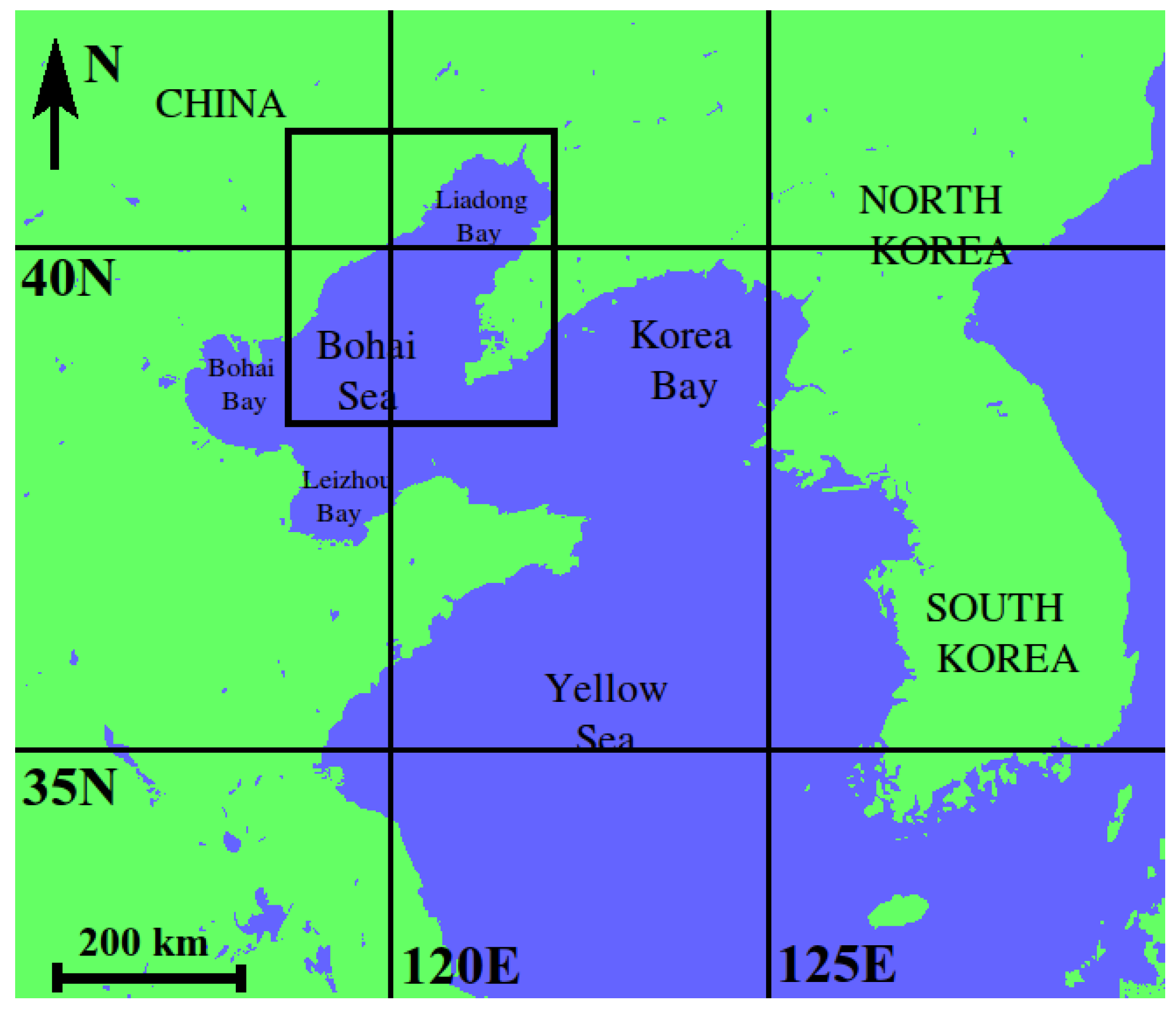
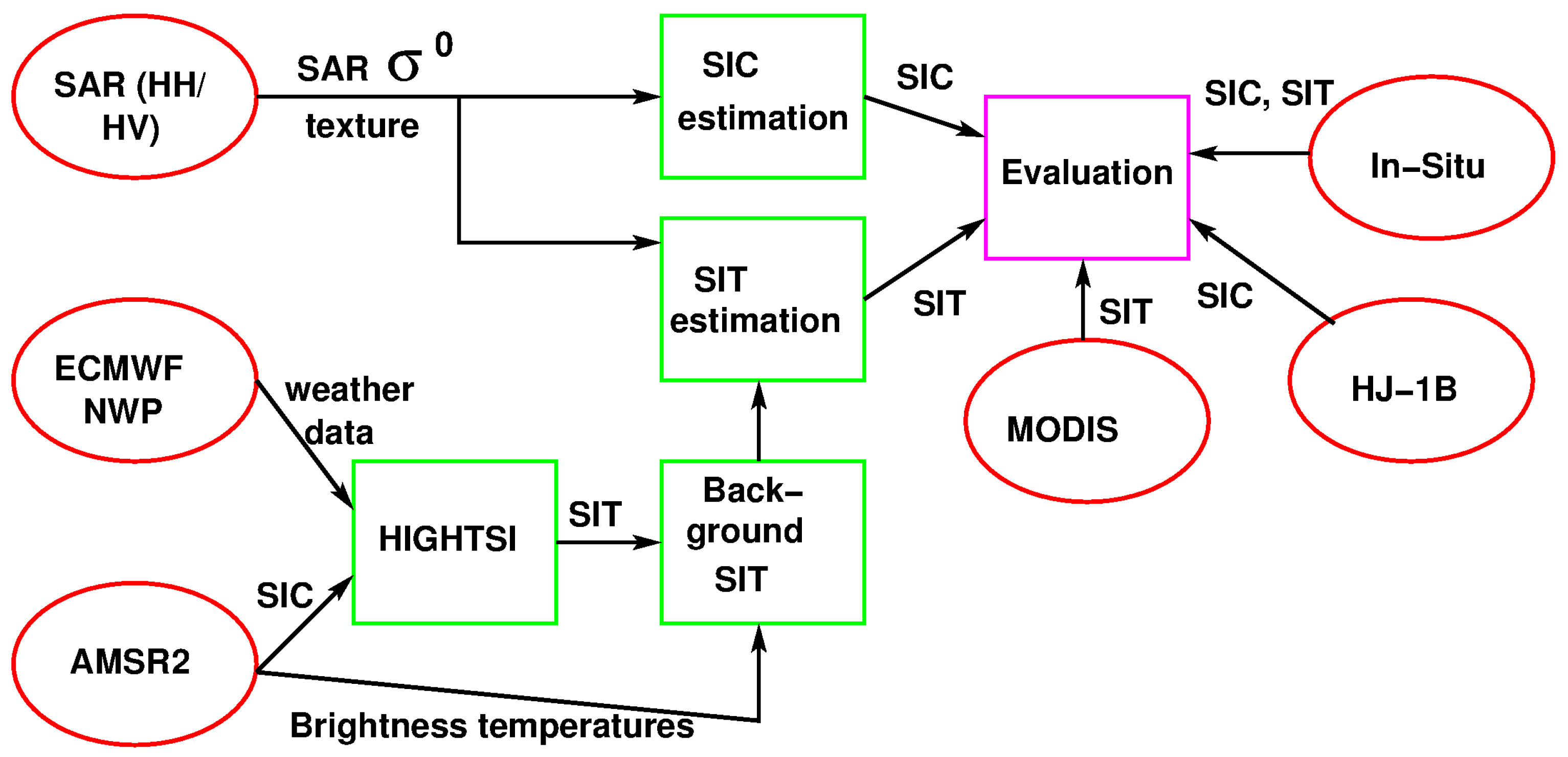
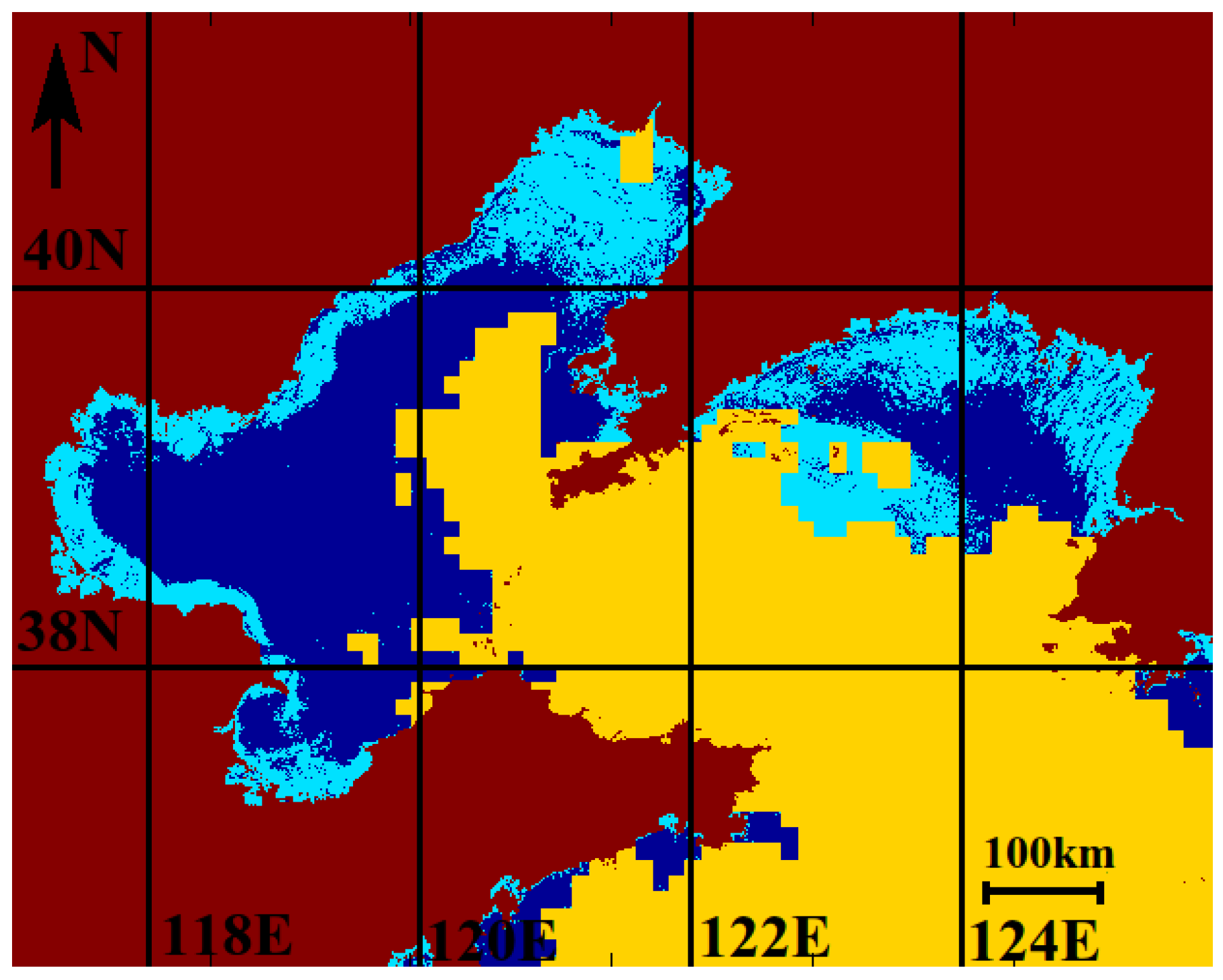
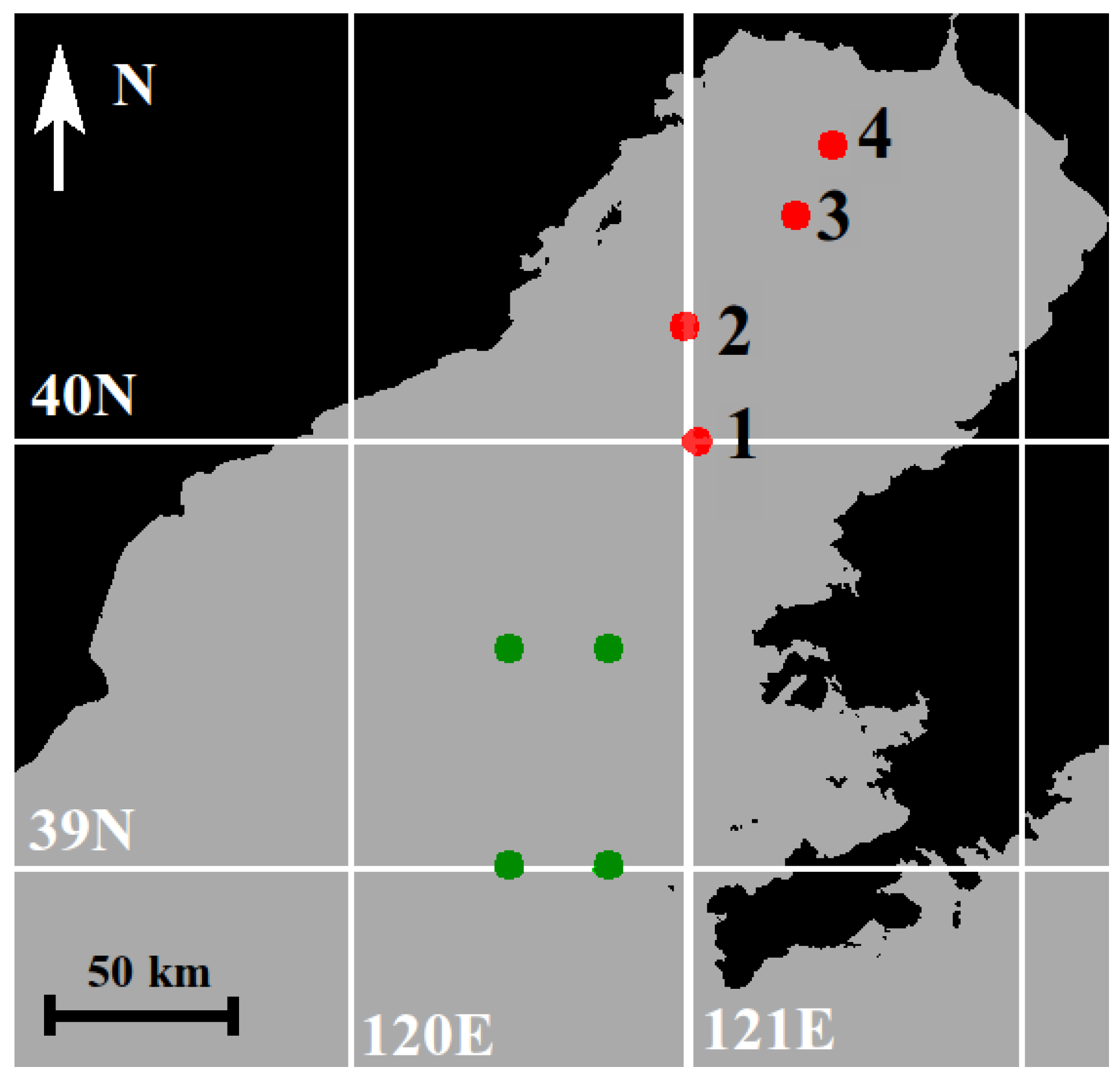
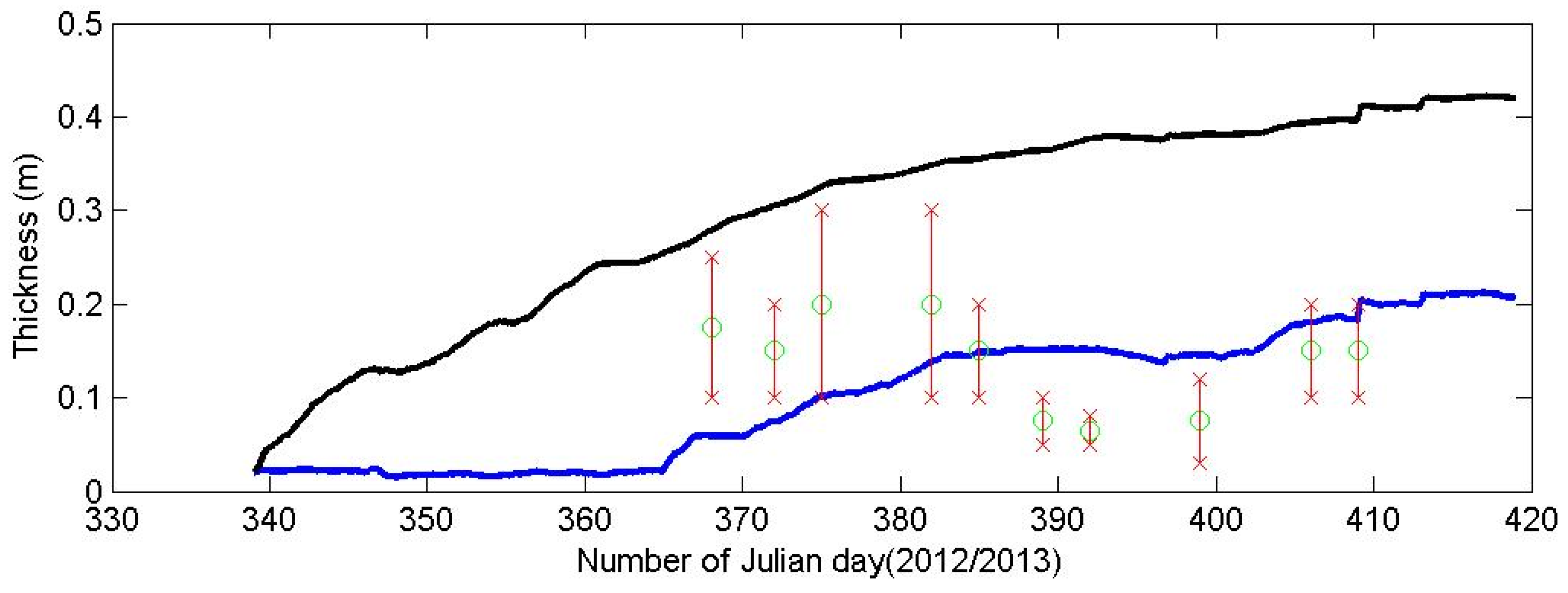
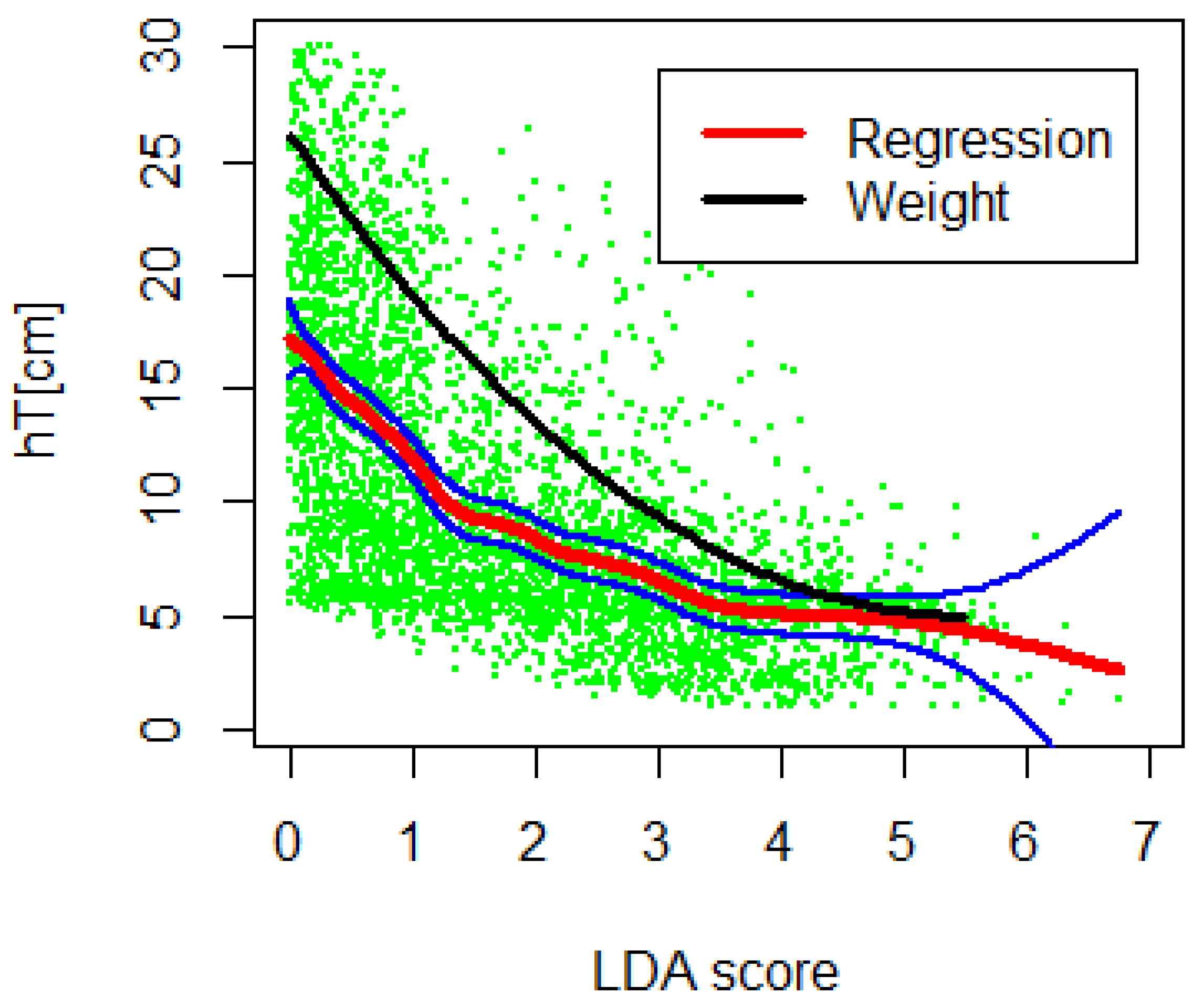
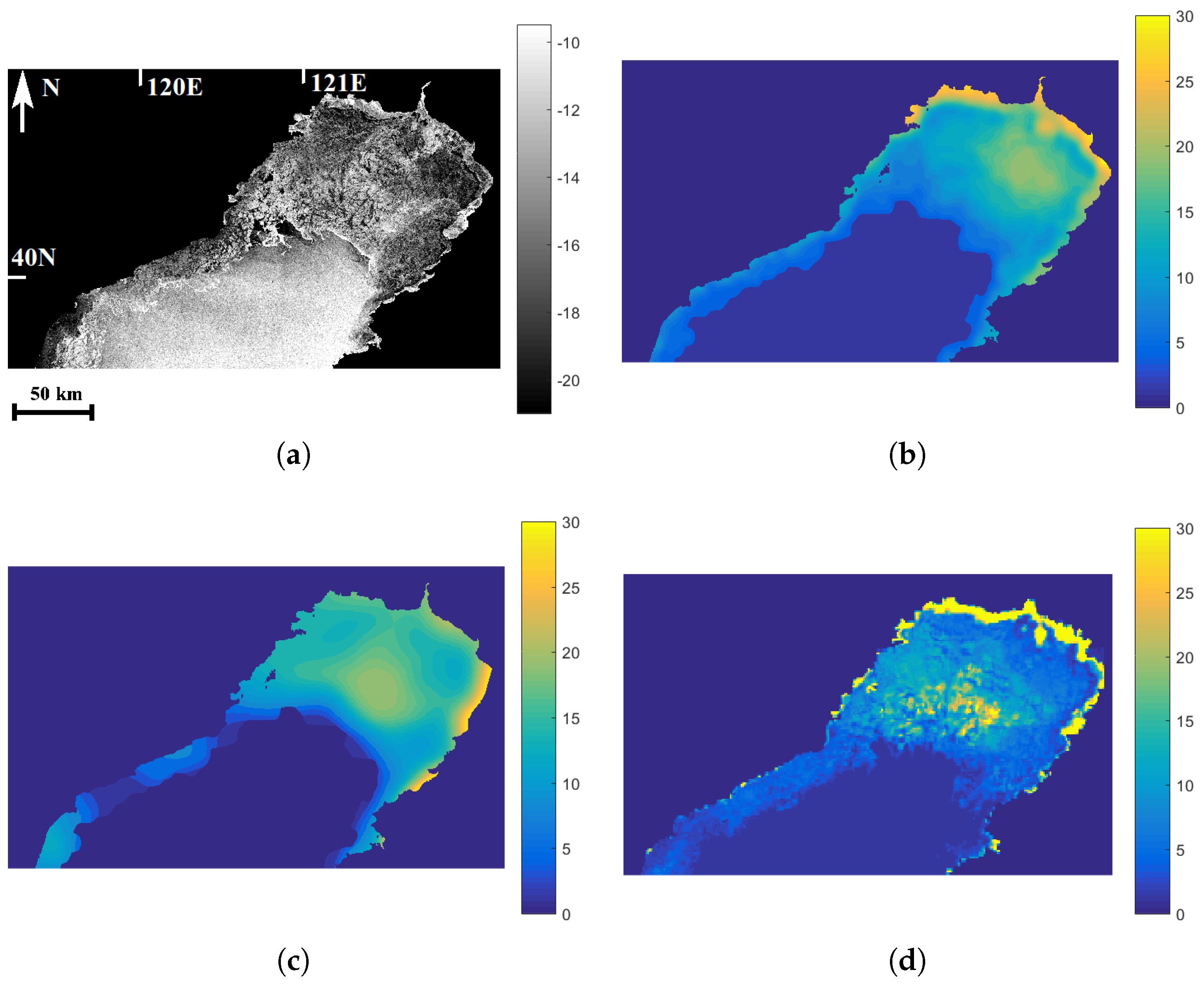
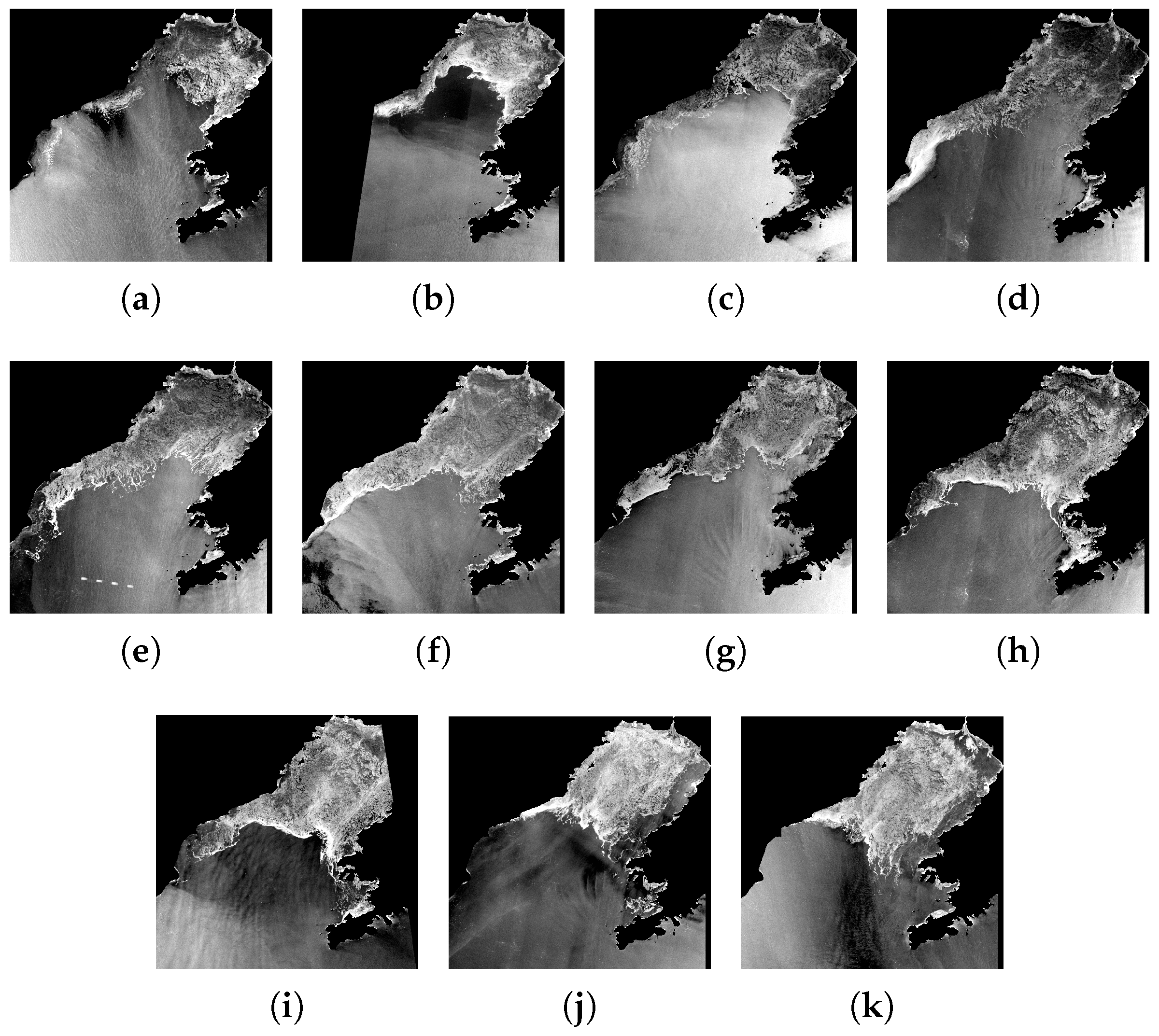
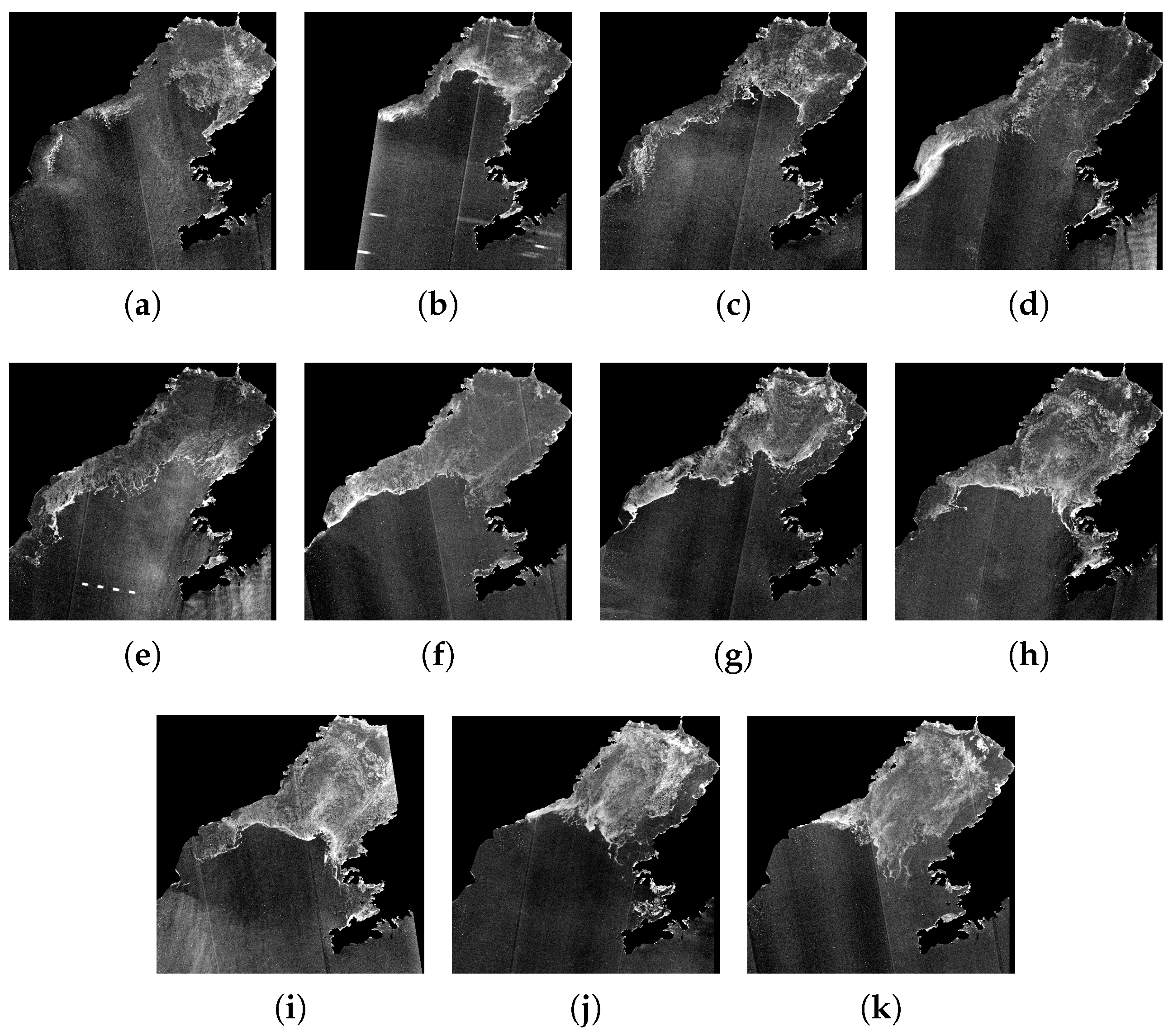
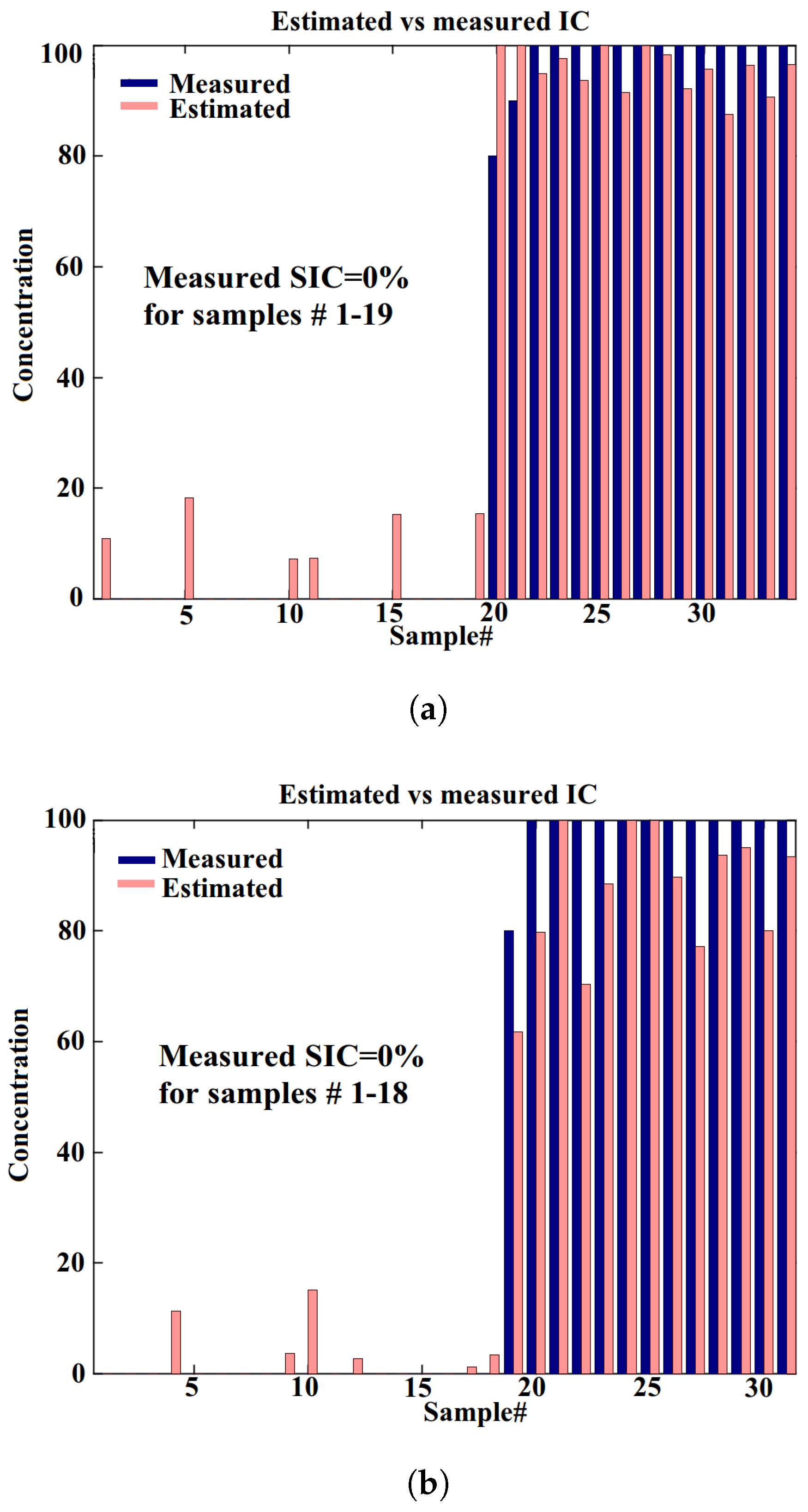
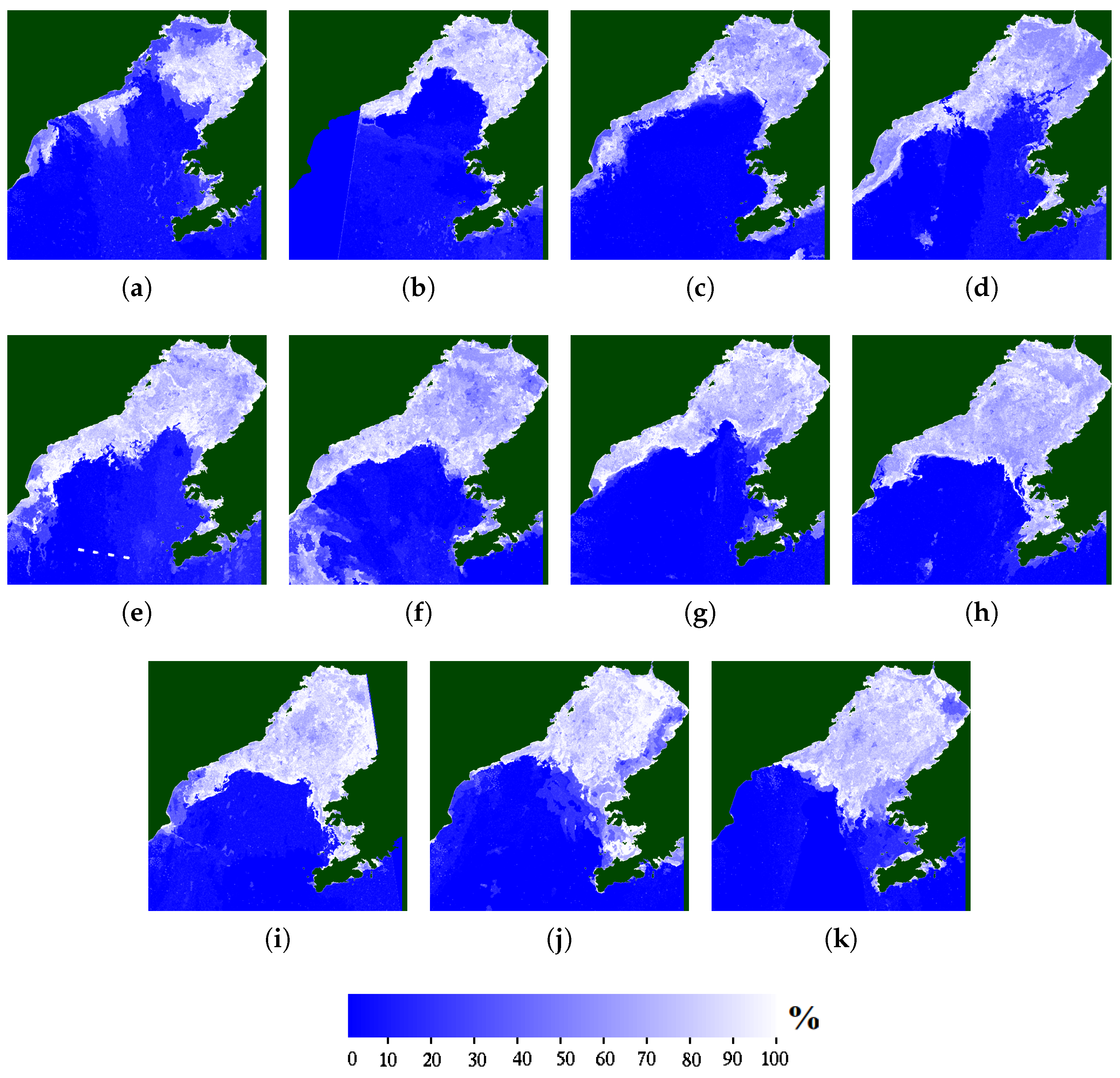
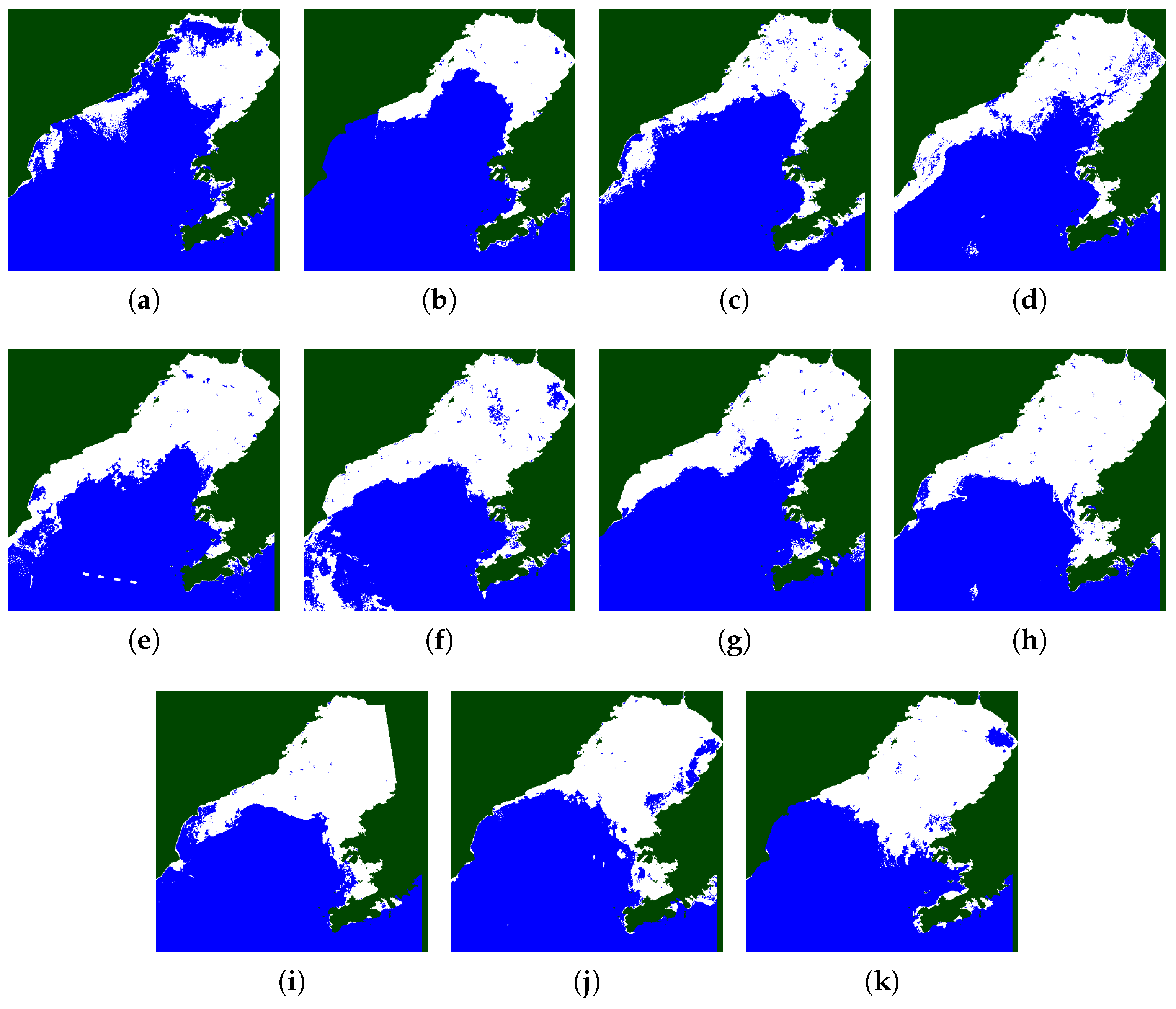


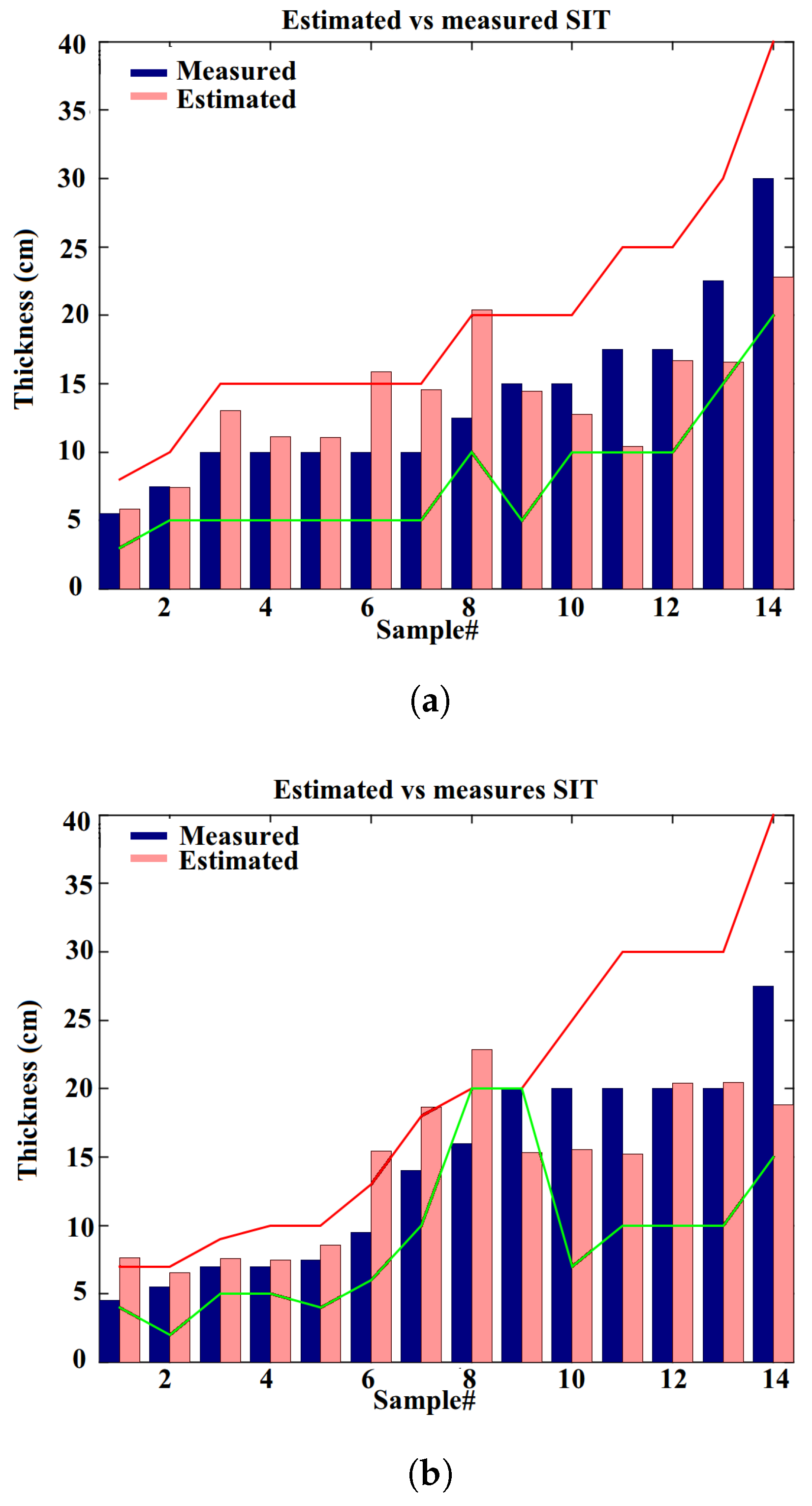
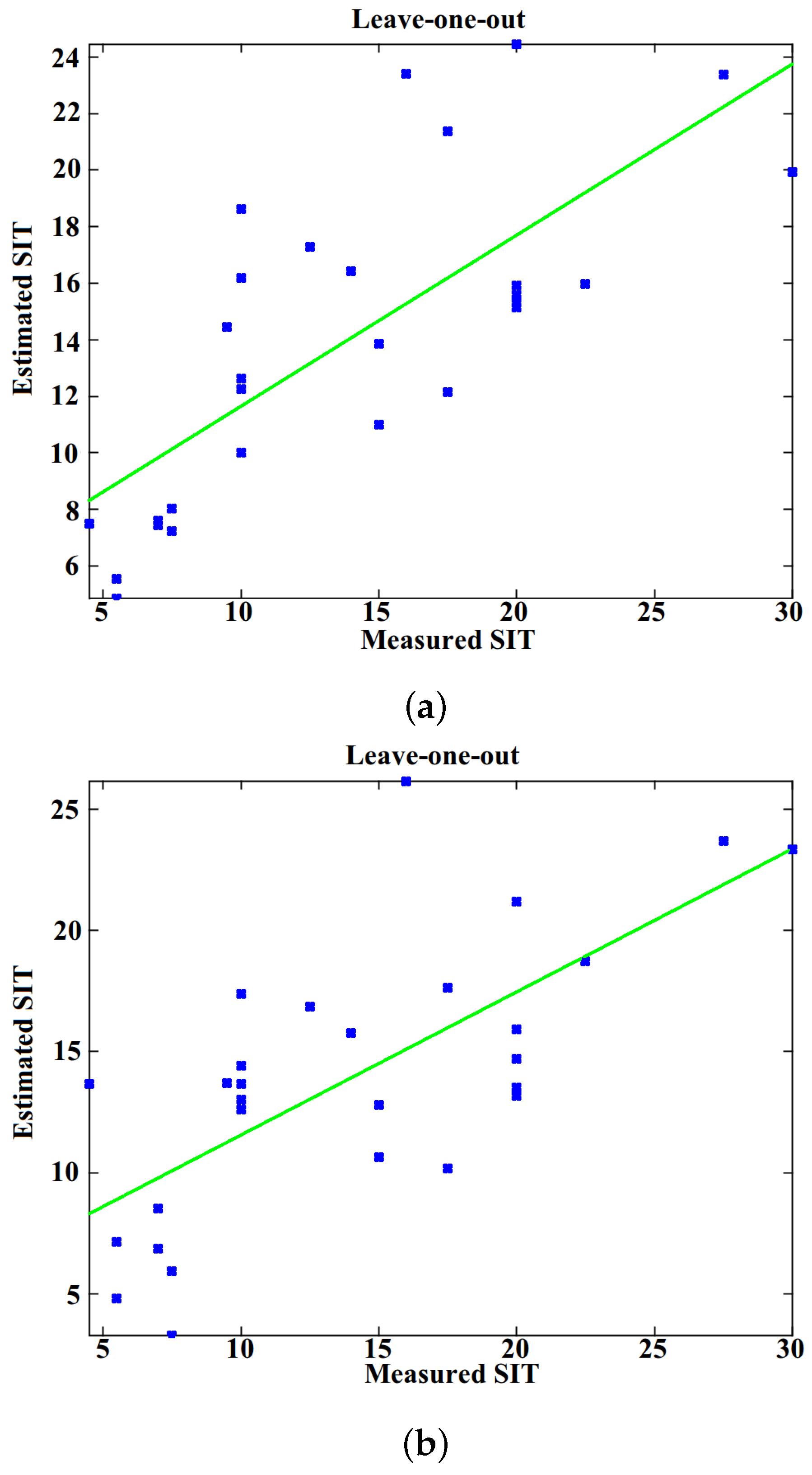
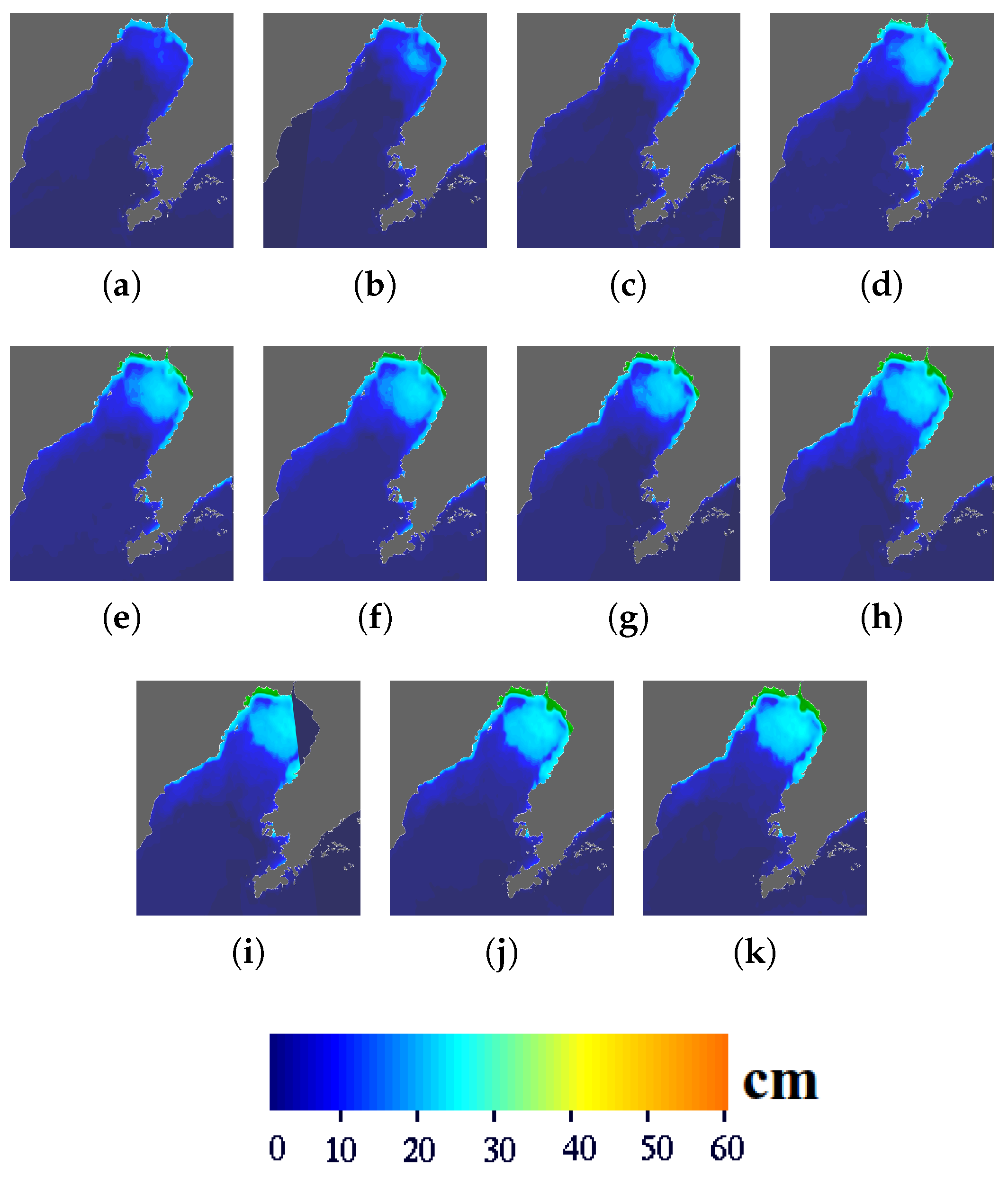
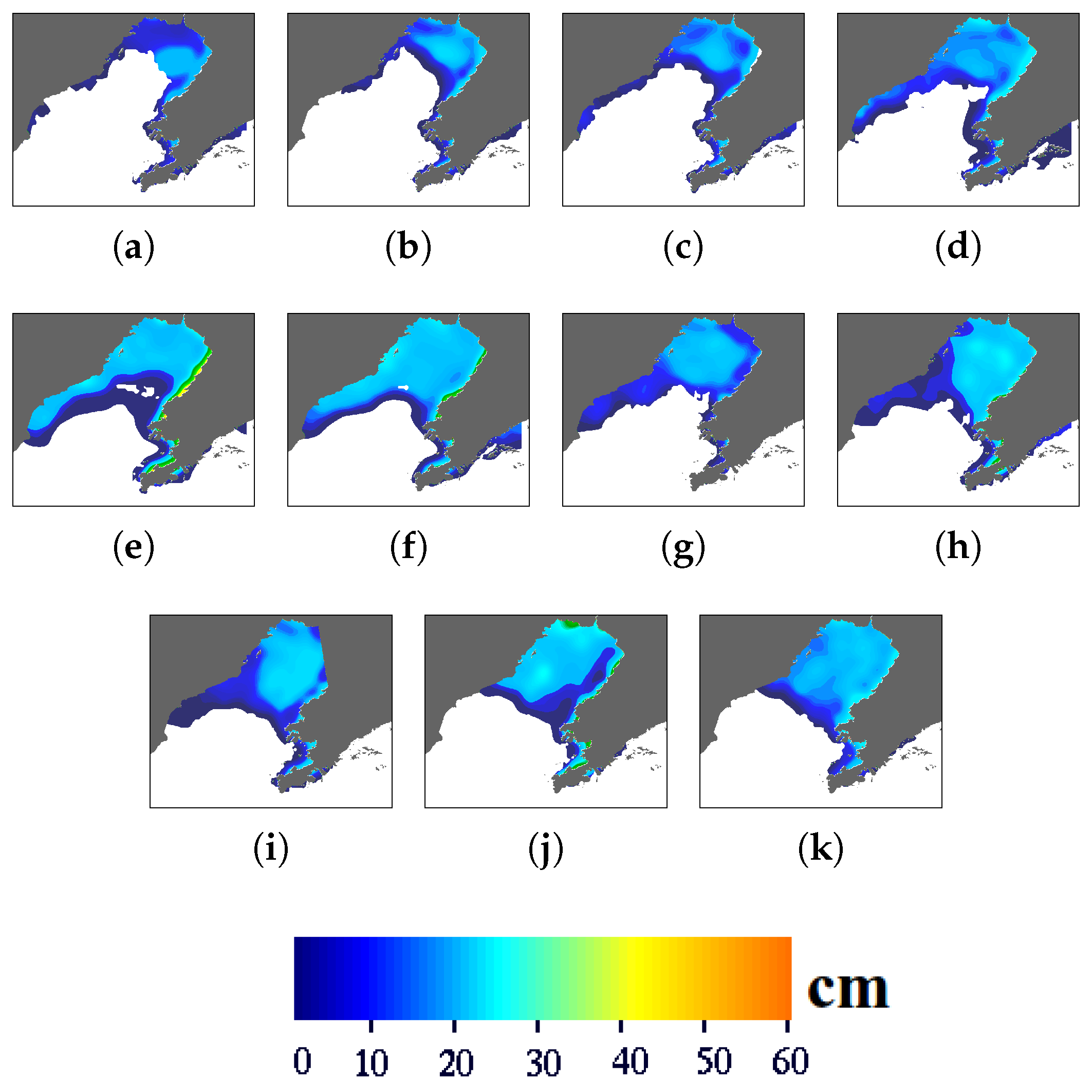
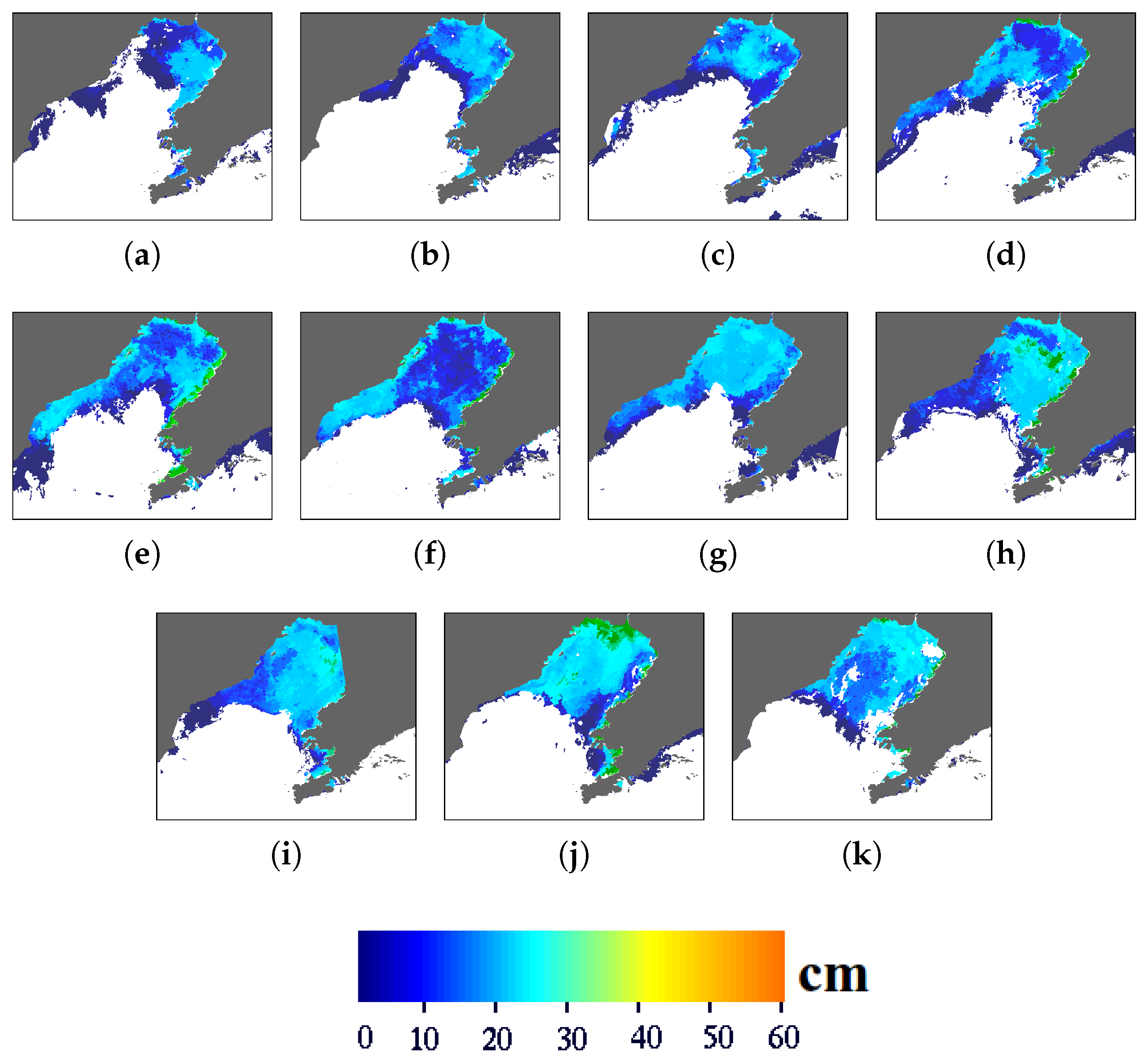

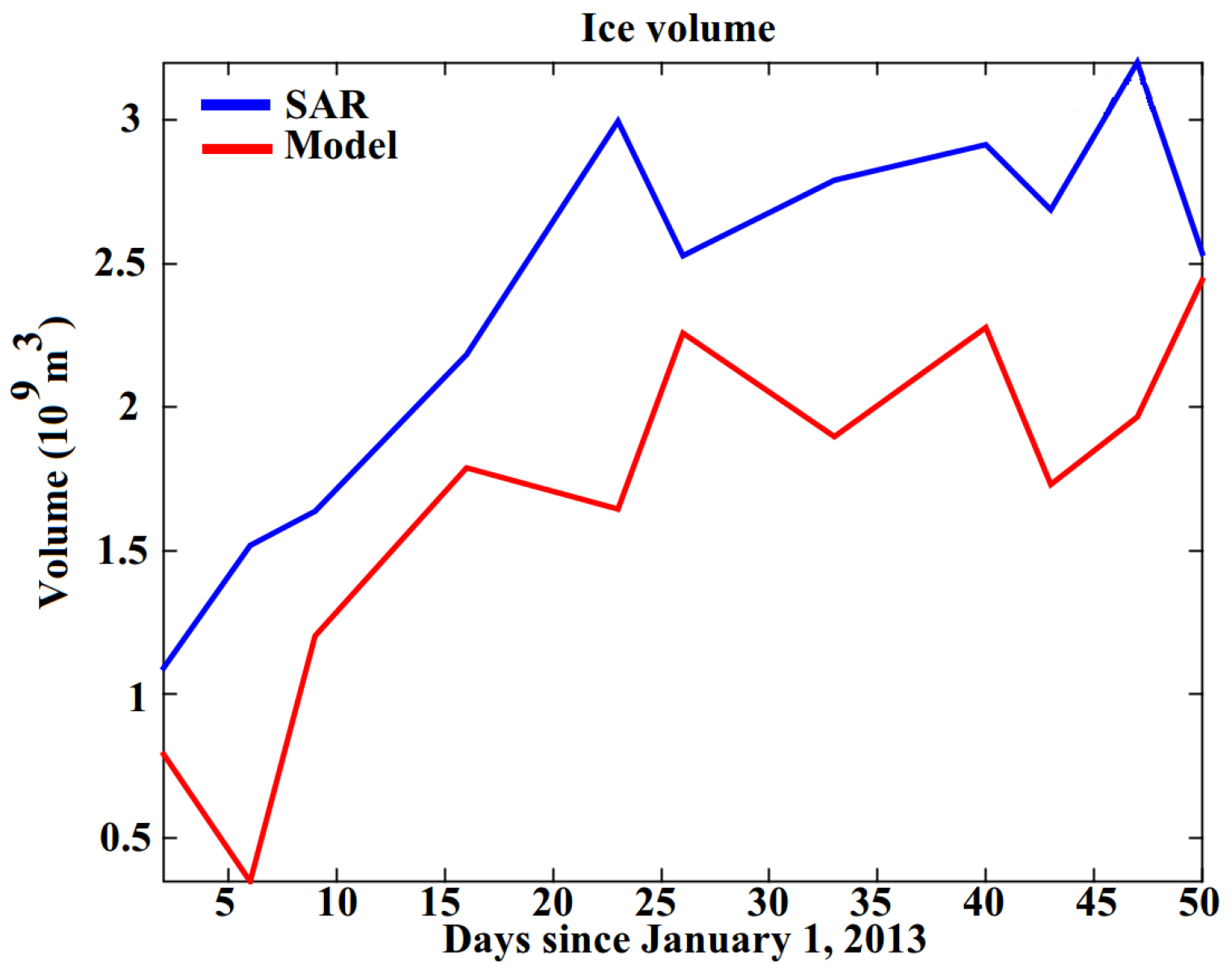
| Date | Acquisition Start Time (UTC) | Orbit | Center (Lat, Long) () |
|---|---|---|---|
| 2 January 2013 | 09:56:20 | Ascending | 38.85 N, 120.05 E |
| 6 January 2013 | 21:53:00 | Descending | 38.89N, 122.89E |
| 9 January 2013 | 22:06:16 | Descending | 39.18N, 119.79E |
| 16 January 2013 | 22:02:01 | Descending | 39.29N, 120.87E |
| 23 January 2013 | 21:57:52 | Descending | 39.16N, 121.88E |
| 26 January 2013 | 09:56:29 | Ascending | 39.44N, 119.91E |
| 2 February 2013 | 22:06:14 | Descending | 39.27N, 119.81E |
| 9 February 2013 | 22:02:01 | Descending | 39.30N, 120.86E |
| 12 February 2013 | 10:00:38 | Ascending | 39.27N, 118.90E |
| 16 February 2013 | 21:57:51 | Descending | 39.14N, 121.88E |
| 19 February 2013 | 09:56:17 | Ascending | 38.76N, 120.08E |
| Date (2013) | Time (UTC) | Thickness (cm) | |||
|---|---|---|---|---|---|
| Platform | JX1-1 | JZ9-3 | JZ20-2 | JZ25-1S | |
| 2 January 2013 | 09:55 | 4–7 | 10–25 | ||
| 6 January 2013 | 21:53 | 6–13 | 10–20 | ||
| 9 January 2013 | 22:05 | 10–18 | 20–40 | ||
| 16 January 2013 | 22:01 | 2–7 | 10–20 | 5–20 | |
| 23 January 2013 | 21:57 | 5–9 | 5–10 | 5–15 | |
| 26 January 2013 | 09:55 | 5–10 | 4–10 | 3–8 | 5–15 |
| 2 Fabruary 2013 | 22:05 | 5–10 | 7–25 | 3–12 | 15–30 |
| 9 February 2013 | 22:01 | 10–30 | 20 | 5–15 | 5–15 |
| 12 February 2013 | 09:59 | 10–30 | 20 | 5–15 | 10–25 |
| 16 February 2013 | 21:58 | 10–30 | 15–40 | 10–25 | |
| Data Set | Bias | Absolute Error | MSE | R |
|---|---|---|---|---|
| train | 10.8 | 17.6 | 28.2 | 0.64 |
| test | −0.65 | 15.7 | 26.9 | 0.64 |
| Features: | ||||
| Set | Bias (cm) | Abs. Error (cm) | MSE (cm) | R |
| Train | 0.25 | 2.89 | 4.13 | 0.71 |
| Test | −1.21 | 3.53 | 4.17 | 0.74 |
| Features: , | ||||
| Train | 0.08 | 2.39 | 3.48 | 0.79 |
| Test | −2.97 | 4.08 | 5.27 | 0.62 |
| Features: , | ||||
| Train | 0.11 | 2.35 | 2.98 | 0.85 |
| Test | −0.72 | 3.74 | 4.72 | 0.57 |
© 2017 by the authors. Licensee MDPI, Basel, Switzerland. This article is an open access article distributed under the terms and conditions of the Creative Commons Attribution (CC BY) license ( http://creativecommons.org/licenses/by/4.0/).
Share and Cite
Karvonen, J.; Shi, L.; Cheng, B.; Similä, M.; Mäkynen, M.; Vihma, T. Bohai Sea Ice Parameter Estimation Based on Thermodynamic Ice Model and Earth Observation Data. Remote Sens. 2017, 9, 234. https://doi.org/10.3390/rs9030234
Karvonen J, Shi L, Cheng B, Similä M, Mäkynen M, Vihma T. Bohai Sea Ice Parameter Estimation Based on Thermodynamic Ice Model and Earth Observation Data. Remote Sensing. 2017; 9(3):234. https://doi.org/10.3390/rs9030234
Chicago/Turabian StyleKarvonen, Juha, Lijian Shi, Bin Cheng, Markku Similä, Marko Mäkynen, and Timo Vihma. 2017. "Bohai Sea Ice Parameter Estimation Based on Thermodynamic Ice Model and Earth Observation Data" Remote Sensing 9, no. 3: 234. https://doi.org/10.3390/rs9030234







